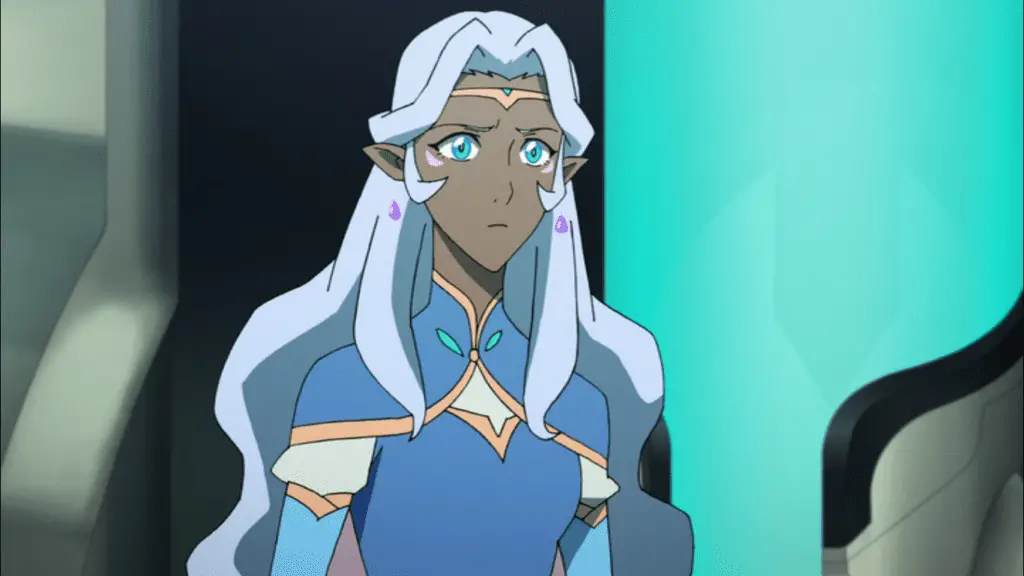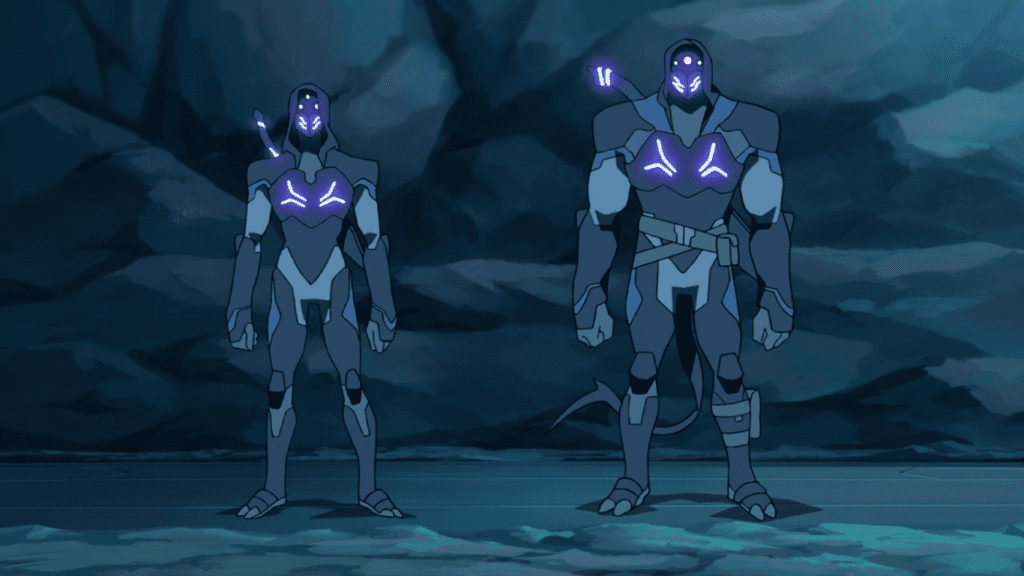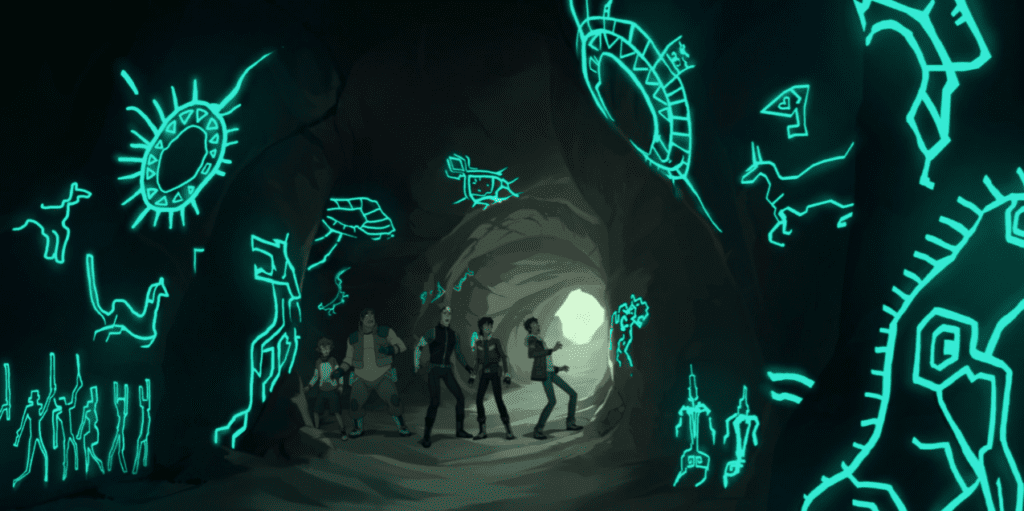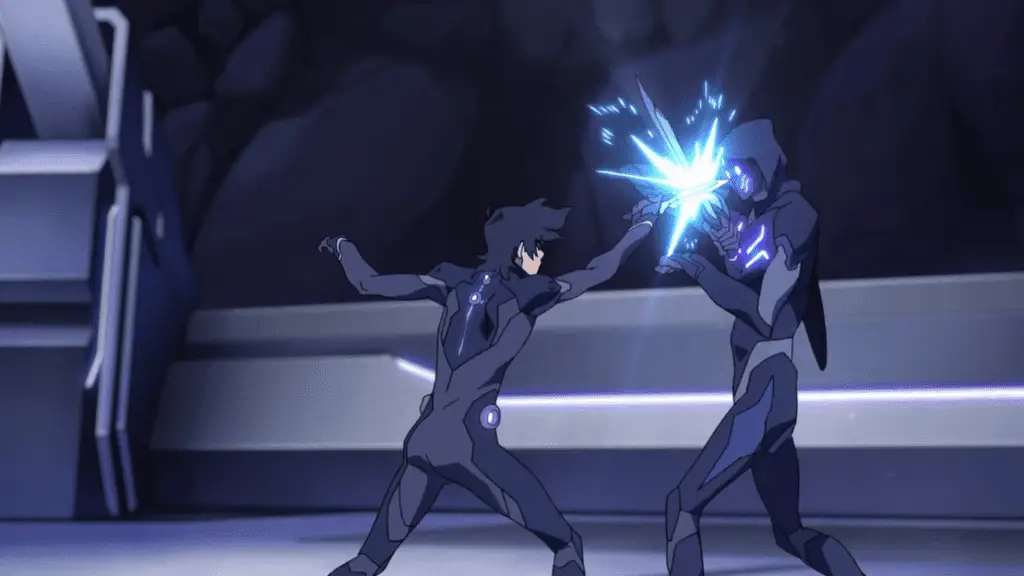Season 2 of Netflix’s Voltron: Legendary Defenders recently dropped on Netflix, and introduced new twists and interesting backstories. However, it’s also had its share of disappointments. For me, a big one was (once again) a lack of female representation. Allura is fantastic, and the new hints that Pidge might be non-binary were exciting beyond words. But those two aside, five of the seven protagonists are male, the vast majority of the villains are male, and although there’s some great female side-characters, there’s still not as many as there could be, let alone as many as I want.
This lack of female and other non-male genders is strange to me. Voltron noticeably does an okay job with racial diversity, though considering the vast majority of characters other than the Paladins and the Alteans are humanoid yet not human looking, there’s only so much they can do. The same is not true for gender, and in fact most of the aliens, particularly the humanoid ones, do exhibit traits that suggest gender. So it disappoints me that there still seems to be a disparity in representation.
It’s worth taking a quick moment to dissect what I mean by “alien gender”. First, it’s important to note that gender is more complex than the male-female binary that it’s often reduced to. Plus, if you believe in aliens as I do (I’m not saying they’re visiting Earth or abducting cows or anything—I’m just saying they’re out there, man), there’s no reason to believe that aliens would have the same gender/sex classification system as humans anyway. Even if they do have a similar biological system, the fact that different human cultures have different ideas about gender leads me to believe that aliens would probably think of gender in radically different ways.
In light of that, it may seem incongruous (and even wrong) to describe aliens as being “male” or “female.” However, the aliens in Voltron are not real aliens. They are fictional aliens, created by human writers and artists for consumption by human audiences; more specifically, Western writers/artists, for a presumably Western, adolescent audience. The majority of Voltron’s viewership is probably not going to be wise to alien gender theory. These viewers are going to be watching the show, seeing the gender markers the writers and artists project onto the aliens, and assuming those aliens are male or female. So when I discuss alien gender, I’m discussing the socially accepted markers of gender that are visible in the aliens. In other words, this is a Doylist lens of analysis.

A good example is Allura. Allura is an Altean, not a human. But she has long hair, delicate features, a high pitched voice/female voice actor (Kimberly Brooks), and the sort of curvy figure that is typically associated with women. Plus, you know, everyone calls her, “Princess.” We don’t know how Altean gender works, but anyone watching the show who is familiar with the Western system of gender will assume she’s female.
The same is true with other, less human-looking aliens. The Balmerans, for example, serve as a great example of how to create humanoid, gendered aliens that aren’t sexualized. But Shay has a high voice and female actor (Emily Eiden), and has either a biological feature or an ornament that resembles earrings, which in Western society are generally considered feminine. This all works to code Shay as female. All of the humanoid alien species encountered so far have features that serve as implicitly gendered short-hands. So it is frustrating that the creators don’t make more effort to have a diverse representation of gender in these side characters.
This isn’t to detract from the fact that there are some great female side characters and aliens. Shay is sensitive and sweet and incredibly brave, and Reyner the Olkarian was tough and smart and practical. However, these are only a couple of characters, who so far have only appeared in two or three episodes at most.
Other more frequently recurring characters, such as Thace, Slav, and Alfor, are all male. Even worse, a not-insignificant portion of the female characters that are introduced are sexualized, and seem to mainly exist for Lance to ogle. The mermaid subplot was really fun and compelling, but why did the mermaids have to be sexy? There’s never any sexy male aliens. Allura has never crash landed on a planet entirely populated by shirtless, muscular lumberjacks who smell like pine. (Dear Voltron writers, if you are reading this and would like to know more, please contact me. I have many ideas for my planet of shirtless lumberjacks. They’re green and they’re great listeners. I will provide you these ideas free of charge.)
But I think that, for me, the most annoying example of this was the Blade of Marmora. This mysterious rebel group shows up. They’re all wearing masks, and the sound of their voices makes it clear that there’s some sort of voice altering technology in play. They’re badass and tough and heroic. I was thinking that this was going to be a great opportunity to introduce some new female characters. It would add a fun twist and subvert expectations of what the Blade of Marmora would be like, and what warriors and freedom fighters in general are like. I think most people unconsciously think of freedom fighters as male, but history shows that women have had, and continue to have, an important role in many rebellions. Plus, if a story is going to have a character who is introduced wearing a mask, then I think that when they take off that mask, the face beneath should be a surprise. What’s the point of the mask, otherwise?
But instead of female freedom fighters, or any sort of surprise at all, all of the Marmorites (to borrow Lance’s phrase) look exactly how you would expect: tough, masculine Galra.

But as I was thinking about this and feeling annoyed, something occurred to me. Every one of the Galrans is male. I cannot think of a single female Galran that we have seen thus far. Haggar was revealed to actually be Altean. All of the Galrans are tall, physically imposing, broad shouldered, and deep voiced. None of them have figures that are coded female in shape. Some of them even have fur that suggests a beard. They are all clearly gendered male.
Not to be too conspiracy theory, but isn’t that…weird?
In fairness, for all that I’m criticizing Voltron for not being diverse enough in terms of gender, they are still usually making an effort. They just didn’t make an effort with the Galra. And sure, 90% of me thinks that’s just an example of unconscious sexism on the part of the writers and artists. It is worth noting that the majority of the Galra are antagonists, and pretty much all of them have been soldiers of some kind (even Paul Glart, space mall cop). Our society has an unconscious bias that violence and evil are typically male traits; no doubt that’s also part of why we don’t have a female Paladin.
Even Haggar, our one female villain, is a witch and conducts her villainy through magic. She is violent and horrible, but she’s portrayed as scheming and manipulative, typically female traits, and quite literally does not get blood on her hands. Magic keeps her at a distance from actual violence. So it’s possible that the Galrans are all male simply because it doesn’t occur to the writers that women can be violent and evil too.
But the other 10% of me can’t help but wonder… Maybe we haven’t seen any female Galra because they don’t look how we’re expecting; perhaps male and female Galra have no visible differences. But what if female Galrans don’t exist at all? There are animal species on earth that have only one sex, so why not an advanced alien species? I still object to the fact that this one sex looks male—I’m not saying they all have to be female, but there are other options, such as androgyny—but it would still be an amazingly cool sci fi idea. It would be powerful to include it in a work of fiction aimed at adolescents. The fact that they are willing to at least suggest that Pidge is non-binary gives me hope that they might actually be doing this.
Galran Gender and Keith
If the Galrans are indeed all “male,” that also gives me some interesting thoughts about Keith.
I’ve seen some theories floating around that Keith’s mother must have been the Galra, and that perhaps she was a Paladin too, maybe even the Paladin for the Blue Lion. On the surface, this makes sense. We have now seen Keith’s dad, who looked totally human, but not Keith’s mom, which automatically raises questions about her. We also know that Keith lived in the vicinity of the Blue Lion, and it seems like it can hardly be a coincidence that the two alien things on Earth were within a few miles of each other.
Personally, I’m skeptical. First, it seemed like it was heavily implied that the Blue Lion had been on Earth for a very long time, possibly since Voltron was first broken apart ten thousand years ago. After all, the Blue Lion was surrounded by mystical cave drawings. If Keith’s mother was the Blue Paladin, presumably she would have had to have been on Earth that long too. Zarkon has lived that long, but it was strongly suggested that Zarkon’s long life span was unnatural, not an example of the usual life span of a Galran. How would Keith’s mother have also lived that long?
I also don’t think that makes sense in terms of Keith’s Galran ancestor being a member of the Blade of Marmora, which Keith’s knife proves they were. If the Blade of Marmora was formed after Zarkon came into power, how could a Paladin who went missing as Zarkon came into power be part of the group?

But to get back to the theory about Galran gender: for Keith’s mother to be a full-blooded Galran and a woman, as she presumably is if she’s his mother, then that would be a pretty bizarre break from the masculinity of the Galrans we’ve seen so far. Even if I’m wrong about the Galrans and their gender, it would be weird and a little insulting if the first female Galran we see is A) put into the stereotypical female role of a mother, and B) fridged, as Keith’s mother seems to be.
I don’t want to believe in Keith’s mother being a female Galran, because it would just make Voltron’s woman problem worse. And if I am right and the writers of Voltron are intending the Galrans to be a species with only one gender, then Keith’s mother can’t be a full blooded Galran. (Unless, hear me out…give Keith two gay dads.)
I think there’s a way to write this that would resolve the timeline issues, work with my theory about Galran gender, answer some other small questions about Keith, and give the writers an opportunity to explore gender identity and masculinity, which is as follows:
After the Blue Lion disappeared, Zarkon’s forces were of course looking for it. The Blade of Marmora began looking too, either to get their hands on it first or just to keep Zarkon from getting it, and somehow the Marmorites found the Lion before Zarkon did. At some point in Earth’s history, possibly decades or centuries ago, they sent an operative to find the Lion. He was unable to access it, since he wasn’t its Paladin, so he settled in over the years to guard it. He eventually had a relationship with a human and had a child, and this was Keith’s ancestor generations back.
That could explain a lot of simple questions I have, such as Keith’s totally human appearance. If Keith is half-Galran, why doesn’t he have any Galran physical traits? You know, like being purple. Or having a tail. If his Galran ancestry is several generations back, then he would be more human than Galran and could reasonably look human. It could also explain why, when he underwent the Blade of Marmora’s trial, his blade took so long to awaken. The Marmorites all thought that the fact that the blade didn’t immediately react to Keith during the trial must be proof it didn’t belong to him. This suggests the blades do ordinarily react quickly. But perhaps because Keith’s Galran ancestry is buried deeply, his blade did not initially recognize him as Galran and took longer to react than it would with someone of pure Galran ancestry.
I think the most interesting thing would be the questions it would let the writers raise about Keith’s gender identity. Of course, Keith’s own feelings about his gender are the most important thing—if he identifies as male, then he is. That’s how it works. Nonetheless, Keith’s Galran ancestry and the Galran gender system could create a complexity worth exploring. Keith is, in many ways, a picture of masculinity. He’s extremely physically strong and tough. He’s aggressive, always willing to fight, and rarely runs away from any challenge. He’s emotionally closed off, rarely talking about his feelings. He’s heroic, cool, and handsome. He’s a man’s man.

But if the Galrans don’t have women, can they possibly have men? Human concepts of ideas often function through opposites or conflicting ideas. For instance, you can only understand “light” because you know about the dark. If you had spent your entire life living in light, would it ever occur to you to notice it? There are many ideas that make up a conception of gender, but one of the things that is often used to define “male” and “female” is “not female” and “not male.” So if the Galrans cannot think of themselves as being “not female,” are they able to think of themselves as “male”? Why would they have bothered to invent such a concept?
Humans do have gender, and Keith was raised with those ideas. Nonetheless, being introduced to the concept that one of his ancestral species would not conceive of themselves or of him as being male could easily be used to lead into questioning his own identity. Since Keith is such a masculine ideal, that would inherently question masculinity itself. For a show that has thus far been invested in male characters and their stories, that would be a powerful twist. It would also be effective for showing boys and young men that masculinity is not necessarily a model they are required to live up to, but just one way out of many for thinking about themselves.
Ultimately, Keith could still conclude that he identifies as a man, but I would love to see Keith find a healthier balance in his masculinity, perhaps a turn where he becomes less willing to recklessly sacrifice himself and more willing to open up to his friends. And it would be a powerful gesture for masculinity to be something that Keith chooses, rather than passively accepting. It would shred the concept of toxic masculinity, while still finding a way to celebrate maleness.
In other words, without having to add more female characters, Voltron could add a striking feminist twist to its story.

